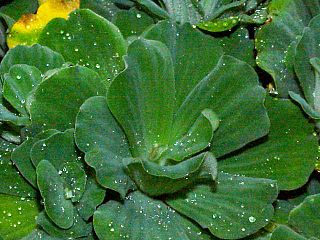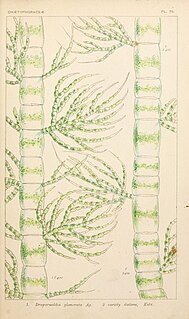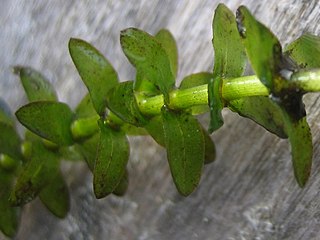
Algae is an informal term for a large, diverse group of photosynthetic eukaryotic organisms that are not necessarily closely related, and is thus polyphyletic. Included organisms range from unicellular microalgae, such as Chlorella and the diatoms, to multicellular forms, such as the giant kelp, a large brown alga which may grow up to 50 m in length. Most are aquatic and autotrophic and lack many of the distinct cell and tissue types, such as stomata, xylem, and phloem, which are found in land plants. The largest and most complex marine algae are called seaweeds, while the most complex freshwater forms are the Charophyta, a division of green algae which includes, for example, Spirogyra and the stoneworts.

An epiphyte is an organism that grows on the surface of a plant and derives its moisture and nutrients from the air, rain, water or from debris accumulating around it. Epiphytes take part in nutrient cycles and add to both the diversity and biomass of the ecosystem in which they occur, like any other organism. They are an important source of food for many species. Typically, the older parts of a plant will have more epiphytes growing on them. Epiphytes differ from parasites in that they grow on other plants for physical support and do not necessarily affect the host negatively. An epiphytic organism that is not a plant is sometimes called an epibiont. Epiphytes are usually found in the temperate zone or in the tropics. Epiphyte species make good houseplants due to their minimal water and soil requirements. Epiphytes provide a rich and diverse habitat for other organisms including animals, fungi, bacteria, and myxomycetes.

The glaucophytes, also known as glaucocystophytes or glaucocystids, are a small group of rare freshwater microscopic algae. Together with the red algae (Rhodophyta) and the green algae plus land plants, they form the Archaeplastida. However, the relationships among the red algae, green algae and glaucophytes are unclear, in large part due to limited study of the glaucophytes.

The green algae are a large, informal grouping of algae consisting of the Chlorophyta and Charophyta/Streptophyta, which are now placed in separate divisions, as well as the potentially more basal Mesostigmatophyceae, Chlorokybophyceae and Spirotaenia.

Water gardens, also known as aquatic gardens, are a type of water feature. They can be defined as any interior or exterior landscape or architectural element whose primary purpose is to house, display, or propagate a particular species or variety of aquatic plant. The primary focus is on plants, but they will sometimes also house ornamental fish, in which case the feature will be a fish pond.

Pistia is a genus of aquatic plant in the arum family, Araceae. The single species it comprises, Pistia stratiotes, is often called water cabbage, water lettuce, Nile cabbage, or shellflower. Its native distribution is uncertain, but probably pantropical; it was first discovered from the Nile near Lake Victoria in Africa. It is now present, either naturally or through human introduction, in nearly all tropical and subtropical fresh waterways and considered an invasive species as well as a mosquito breeding habitat. The genus name is derived from the Greek word πιστός (pistos), meaning "water," and refers to the aquatic nature of the plants.

Caulerpa is a genus of seaweeds in the family Caulerpaceae. They are unusual because they consist of only one cell with many nuclei, making them among the biggest single cells in the world. A species in the Mediterranean can have a stolon more than 3 metres (9.8 ft) long, with up to 200 fronds. This species can be invasive from time to time.

Periphyton is a complex mixture of algae, cyanobacteria, heterotrophic microbes, and detritus that is attached to submerged surfaces in most aquatic ecosystems. The related term Aufwuchs refers to the collection of small animals and plants that adhere to open surfaces in aquatic environments, such as parts of rooted plants. Periphyton serves as an important food source for invertebrates, tadpoles, and some fish. It can also absorb contaminants, removing them from the water column and limiting their movement through the environment. The periphyton is also an important indicator of water quality; responses of this community to pollutants can be measured at a variety of scales representing physiological to community-level changes. Periphyton has often been used as an experimental system in, e.g., pollution-induced community tolerance studies.

Viridiplantae are a clade of eukaryotic organisms made up of the green algae, which are primarily aquatic, and the land plants (embryophytes), which emerged within them. Green algae traditionally excludes the land plants, rendering them a paraphyletic group. Since the realization that the embryophytes emerged from within the green algae, some authors are starting to include them. They have cells with cellulose in their cell walls, and primary chloroplasts derived from endosymbiosis with cyanobacteria that contain chlorophylls a and b and lack phycobilins. More than 350,000 species of Viridiplantae exist.

Riccia fluitans, whose common name is floating crystalwort, is an aquatic floating plant of the liverwort genus Riccia which is popular among aquarists as a retreat for young fry and is used in live-bearing tanks. It can be found floating in ponds, and often forms thick mats on and under the water surface.
Algae eater, also called an algivore, is a common name for many bottom-dwelling or algae-eating species that feed on algae. Algae eaters are important for the fishkeeping hobby and many are commonly kept by hobbyists.
Some of the common and most popular freshwater algae eaters in aquariums include:
In botany, a zoid or zoïd is a reproductive cell that possesses one or more flagella, and is capable of independent movement. Zoid can refer to either an asexually reproductive spore or a sexually reproductive gamete. In sexually reproductive gametes, zoids can be either male or female depending on the species. For example, some brown alga (Phaeophyceae) reproduce by producing multi-flagellated male and female gametes that recombine to form the diploid sporangia. Zoids are primarily found in some protists, diatoms, green alga, brown alga, non-vascular plants, and a few vascular plants. The most common classification group that produces zoids is the heterokonts or stramenopiles. These include green alga, brown alga, oomycetes, and some protists. The term is generally not used to describe motile, flagellated sperm found in animals. Zoid is also commonly confused for zooid which is a single organism that is part of a colonial animal.

Draparnaldia is a genus of freshwater green algae in the family Chaetophoraceae. Draparnaldia are uniseriate; each filament is composed of a chain of cells arranged in one row. Chloroplasts appear as a band within the center of each cell. The length of the main axis cells are generally the same, regardless of whether or not they bear branches. These side branches are divided extensively into terminal hairs. The entire plant is enveloped in loose, slippery mucilage. Draparnaldia is a cosmopolitan genus with wide distribution and it is usually found in cold aerated waters.They are either attached to sand or grow epiphytically on other aquatic plants. Draparnaldia can be seen growing in clear streams trailing on stones and boulders. Herman S. Forest of The Southern Appalachian Botanical Club has stated that while not common, it is present frequently enough to be recorded in almost all local flora lists of green algae that have been compiled. A multitude of species are present in Lake Baikal, Siberia and have been described by Meyer and Jasnitzky. A species of the genus had been placed and described in the Linnean Herbarium as Conferva Mutabilis Roth in 1797. Nowadays Conferva is no longer used and the species is described as Draparnaldia mutabilis (Roth) Bory. Bory is added in honour of the researcher of the same name, based on whose description the genus was separated from similar appearing forms. Bory is accredited with the establishment of the genus.

Monostroma is a genus of marine green algae (seaweed) in the family Monostromataceae. As the name suggests, algae of this genus are monostromatic. Monostroma kuroshiense, an algae of this genus, is commercially cultivated in East Asia and South America for the edible product "hitoegusa-nori" or "hirohano-hitoegusa nori", popular sushi wraps. Monostroma oligosaccharides with degree of polymerization 6 prepared by agarase digestion from Monostroma nitidum polysaccharides have been shown to be an effective prophylactic agent during in vitro and in vivo tests against Japanese encephalitis viral infection. The sulfated oligosaccharides from Monostroma seem to be promising candidates for further development as antiviral agents. The genus Monostroma is the most widely cultivated genus among green seaweeds.

Plants are mainly multicellular, predominantly photosynthetic eukaryotes of the kingdom Plantae. Historically, plants were treated as one of two kingdoms including all living things that were not animals, and all algae and fungi were treated as plants. However, all current definitions of Plantae exclude the fungi and some algae, as well as the prokaryotes. By one definition, plants form the clade Viridiplantae, a group that includes the flowering plants, conifers and other gymnosperms, ferns and their allies, hornworts, liverworts, mosses and the green algae, but excludes the red and brown algae.

Zannichellia is a genus of submerged aquatic flowering plant, with threadlike leaves and tiny flowers. It is fully adapted to an aquatic life cycle, including underwater pollination.

A biofertilizer is a substance which contains living microorganisms which, when applied to seeds, plant surfaces, or soil, colonize the rhizosphere or the interior of the plant and promotes growth by increasing the supply or availability of primary nutrients to the host plant. Biofertilizers add nutrients through the natural processes of nitrogen fixation, solubilizing phosphorus, and stimulating plant growth through the synthesis of growth-promoting substances. Biofertilizers can be expected to reduce the use of synthetic fertilizers and pesticides. The microorganisms in biofertilizers restore the soil's natural nutrient cycle and build soil organic matter. Through the use of biofertilizers, healthy plants can be grown, while enhancing the sustainability and the health of the soil. Since they play several roles, a preferred scientific term for such beneficial bacteria is "plant-growth promoting rhizobacteria" (PGPR). Therefore, they are extremely advantageous in enriching soil fertility and fulfilling plant nutrient requirements by supplying the organic nutrients through microorganism and their byproducts. Hence, biofertilizers do not contain any chemicals which are harmful to the living soil.
Ceratophyllum echinatum, commonly called spineless hornwort, is an aquatic perennial plant of the genus Ceratophyllum. It can be found in ponds and lakes. It is principally an eastern North American species and the only species of its genus endemic to North America.
Soil microbiology is the study of microorganisms in soil, their functions, and how they affect soil properties. It is believed that between two and four billion years ago, the first ancient bacteria and microorganisms came about on Earth's oceans. These bacteria could fix nitrogen, in time multiplied, and as a result released oxygen into the atmosphere. This led to more advanced microorganisms, which are important because they affect soil structure and fertility. Soil microorganisms can be classified as bacteria, actinomycetes, fungi, algae and protozoa. Each of these groups has characteristics that define them and their functions in soil.

Cylindrospermum is a genus of filamentous cyanobacteria found in terrestrial and aquatic environments. In terrestrial ecosystems, Cylindrospermum is found in soils, and in aquatic ones, it commonly grows as part of the periphyton on aquatic plants. The genus is heterocystous (nitrogen-fixing) cyanobacteria.


















